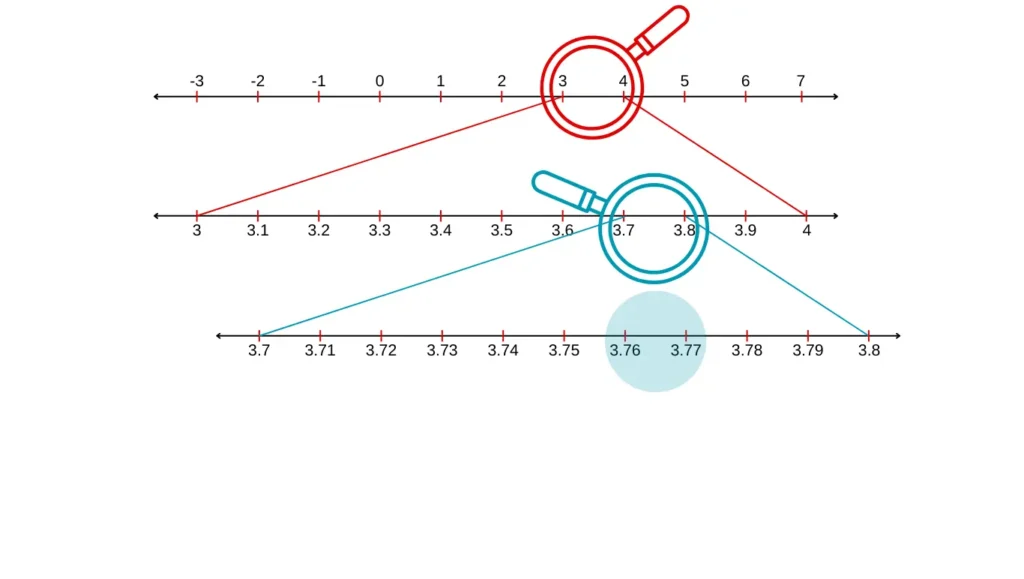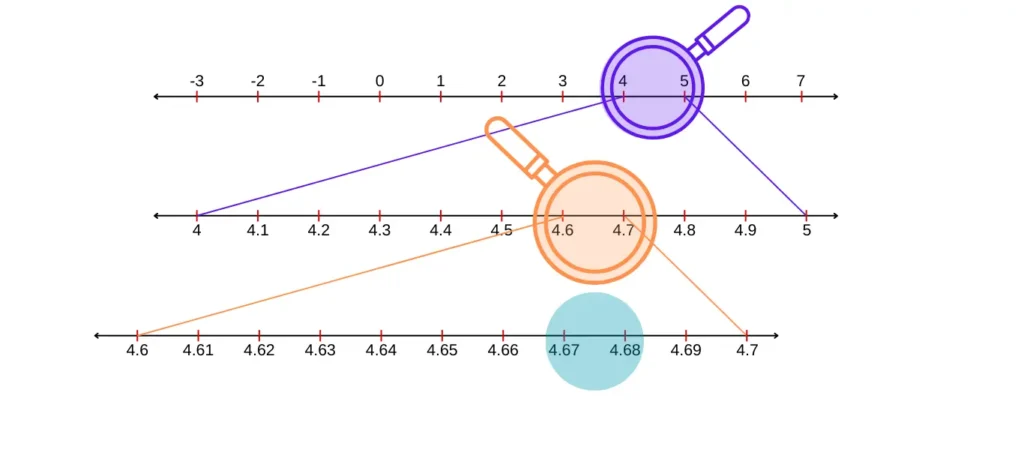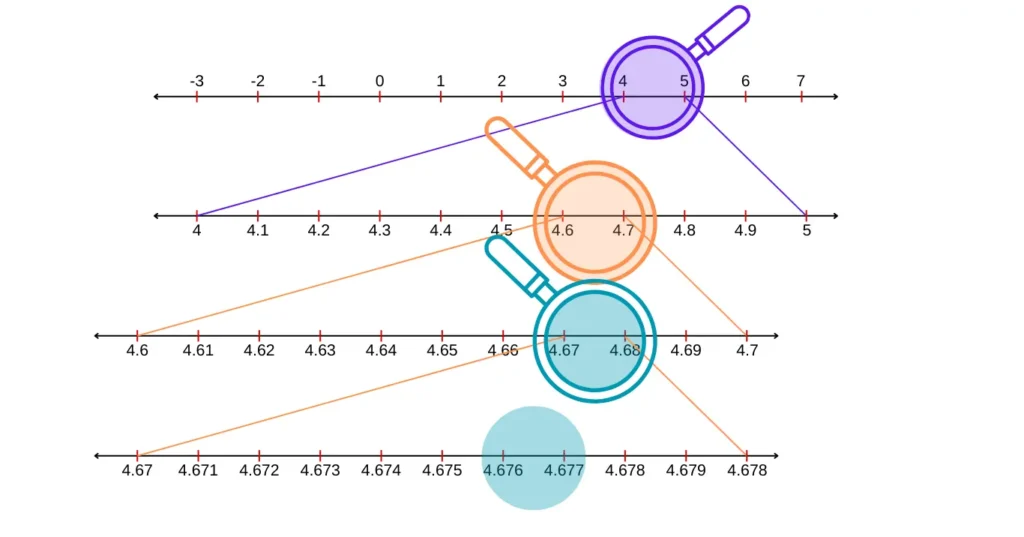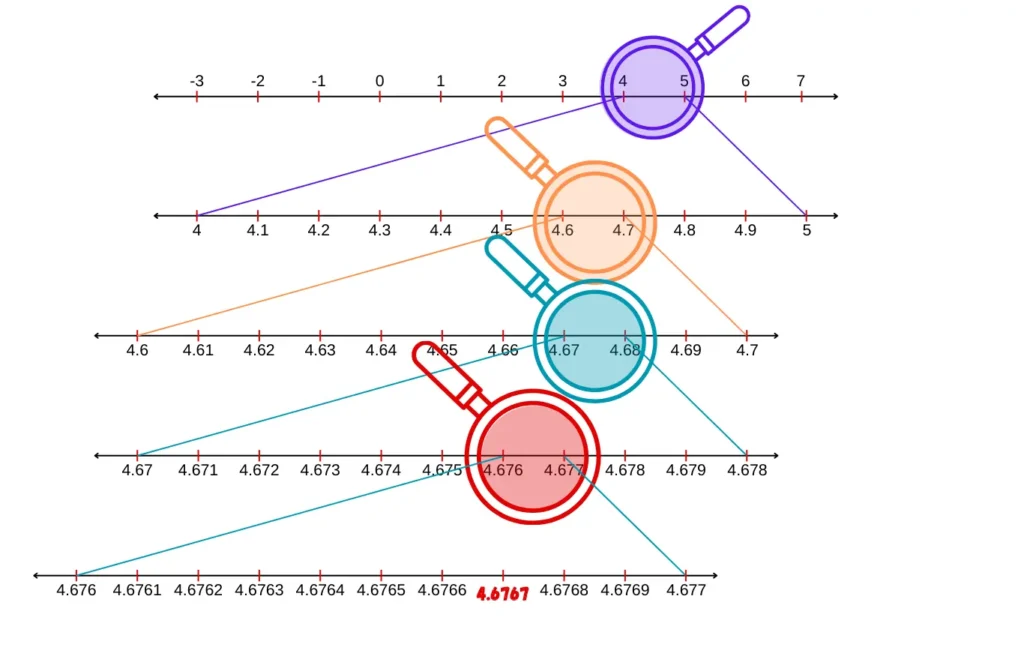
Exercise 1E RS Aggarwal Class 9 contains a total of ten questions. The questions are based on the following topics:
- Representing Irrational numbers on the number line
- Existence of for a given positive real number x
- Representing real numbers on the number line
- Successive Magnification
The first question of Exercise 1E RS Aggarwal Class 9 is representation of the irrational number on the number line.
1. Represent on the number line.
Answer
Since = = .
As '5' is expressible as the sum of the squares of two numbers, we can follow the following steps to represent it on the number line.
Steps to represent on the number line.
Step 3:
Now, we join OB. And with O as centre and OB as radius, we draw an arc, meeting OX at C.
Here, we have followed Pythagoras Theorem to represent on the number line.
Clearly, = = 4 + 1 = 5
⇒ .
So, OB = OC = .
Thus, we have located square root of 5 on the number line.
In Exercise 1E RS Aggarwal Class 9, the second question asks you to find the point on the number line where the square root of 3 is located.
2. Locate on the number line.
Answer
We can write = = =
To represent on the number line, we will start with the representation of first and then we will be able to find the location of on the number line.
Steps to locate on the number line
In Exercise 1E RS Aggarwal Class 9, the third question asks you to find the point on the number line where the square root of 10 is located.
3. Locate on the number line.
Answer
Since = = .
As '10' is expressible as the sum of the squares of two numbers, we can follow the following steps to represent it on the number line.
Steps to represent on the number line.
Step 3:
Now, we join OB. And with O as centre and OB as radius, we draw an arc, meeting OX at C.
Here, we have followed Pythagoras Theorem to represent on the number line.
Clearly, = = 4 + 1 = 5
⇒ .
So, OB = OC = .
Thus, we have located square root of 10 on the number line.
In Exercise 1E RS Aggarwal Class 9, the fourth question asks you to find the point on the number line where the square root of 8 is located.
4. Locate on the number line.
Answer
Since = = .
As '8' is expressible as the sum of the squares of two numbers, we can follow the following steps to represent it on the number line.
Step 3:
With O as centre and OB as radius, we draw an arc, meeting OX at C.
Here, we have followed Pythagoras Theorem to represent on the number line.
Here, OAB is a right angled triangle. So,
= = 4 + 4 = 8
⇒ .
So, OB = OC = .
Thus, we have located square root of 8 on the number line.
In Exercise 1E RS Aggarwal Class 9, the fifth question asks you to find the point on the number line where the square root of 4.7 is located.
5. Represent geometrically on the number line.
Answer
The steps to represent geometrically are as follows.
In Exercise 1E RS Aggarwal Class 9, the sixth question asks you to find the point on the number line where the square root of 10.5 is located.
6. Represent on the number line.
Answer
The steps to represent geometrically are as follows.
In Exercise 1E RS Aggarwal Class 9, the seventh question asks you to find the point on the number line where the square root of 7.28 is located.
7. Represent geometrically on the number line.
Answer
The steps to represent geometrically are as follows.
In Exercise 1E RS Aggarwal Class 9, the eighth question asks you to find the point on the number line where is located.
8. Represent on the number line.
Answer
To represent (1+) on the number line, we first find the position of on the number line as we have done in the other questions of this exercise and then we extend 1 cm more to find the position of 1 + .
The steps to represent geometrically are as follows.
In Exercise 1E RS Aggarwal Class 9, the ninth question asks you to visualize the representation of 3.765 on the number line using successive magnification.
9. Visualize the representation of 3.765 on the number line using successive magnification.
Answer
To visualize means to create a mental image of the number. To visualize 3.765 on the number line, we proceed stepwise as follows.
In Exercise 1E RS Aggarwal Class 9, the tenth question asks you to visualize the representation of a rational number on the number line using successive magnification.
10. Visualize the representation of 4.67 on the number line using successive magnification.
Answer
We have 4.67 = 4.6767(unto 4 decimal places)
To visualize means to create a mental image of the number. To visualize 3.765 on the number line, we proceed stepwise as follows.















































